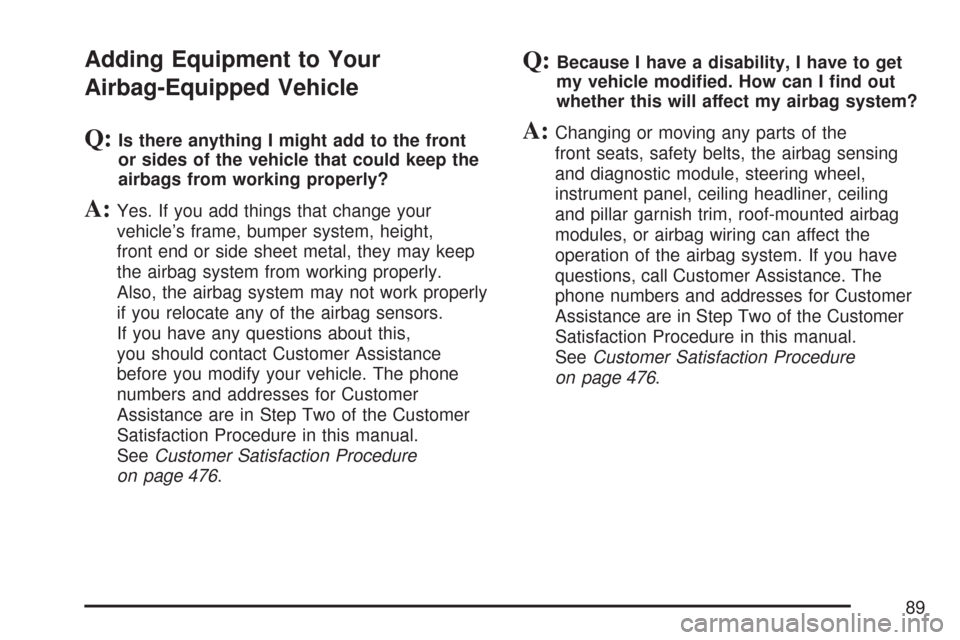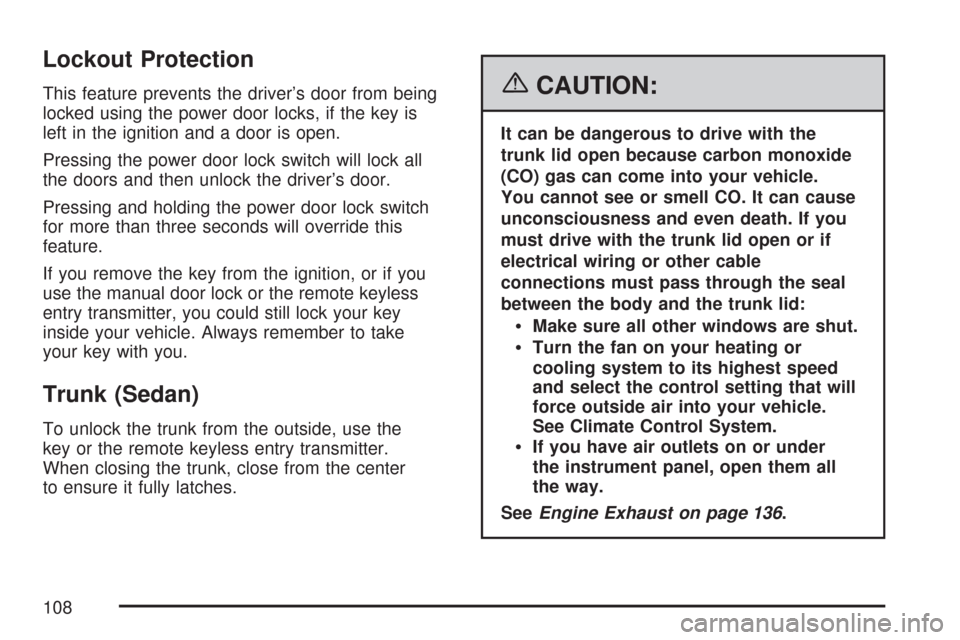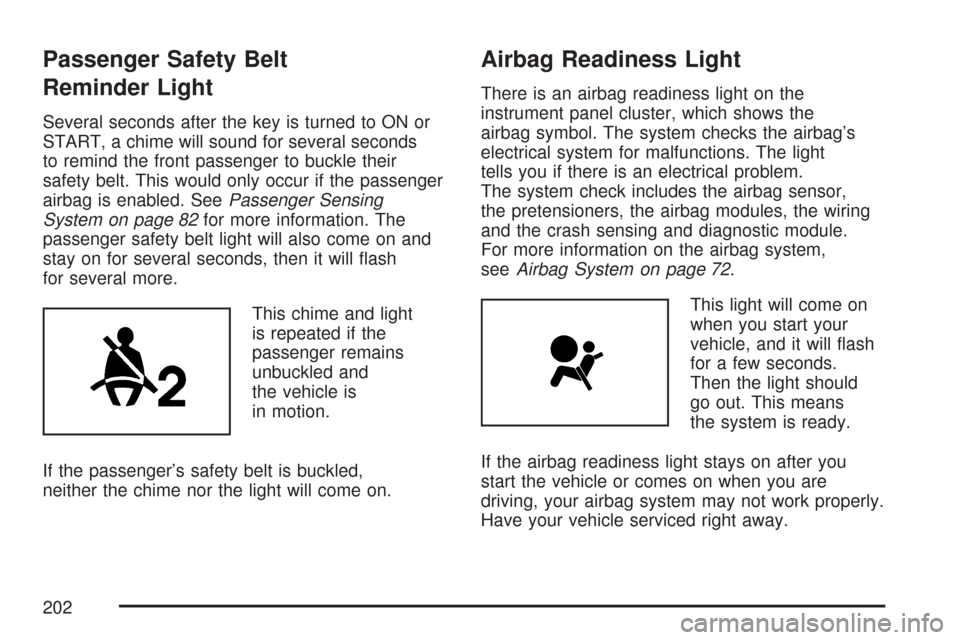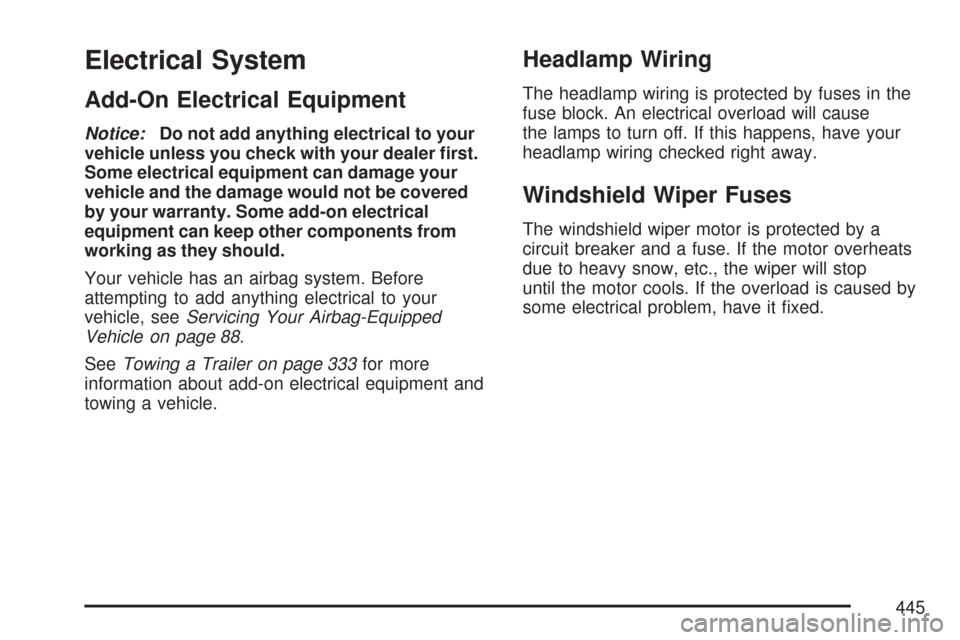Page 89 of 510

Adding Equipment to Your
Airbag-Equipped Vehicle
Q:Is there anything I might add to the front
or sides of the vehicle that could keep the
airbags from working properly?
A:Yes. If you add things that change your
vehicle’s frame, bumper system, height,
front end or side sheet metal, they may keep
the airbag system from working properly.
Also, the airbag system may not work properly
if you relocate any of the airbag sensors.
If you have any questions about this,
you should contact Customer Assistance
before you modify your vehicle. The phone
numbers and addresses for Customer
Assistance are in Step Two of the Customer
Satisfaction Procedure in this manual.
SeeCustomer Satisfaction Procedure
on page 476.
Q:Because I have a disability, I have to get
my vehicle modi�ed. How can I �nd out
whether this will affect my airbag system?
A:Changing or moving any parts of the
front seats, safety belts, the airbag sensing
and diagnostic module, steering wheel,
instrument panel, ceiling headliner, ceiling
and pillar garnish trim, roof-mounted airbag
modules, or airbag wiring can affect the
operation of the airbag system. If you have
questions, call Customer Assistance. The
phone numbers and addresses for Customer
Assistance are in Step Two of the Customer
Satisfaction Procedure in this manual.
SeeCustomer Satisfaction Procedure
on page 476.
89
Page 108 of 510

Lockout Protection
This feature prevents the driver’s door from being
locked using the power door locks, if the key is
left in the ignition and a door is open.
Pressing the power door lock switch will lock all
the doors and then unlock the driver’s door.
Pressing and holding the power door lock switch
for more than three seconds will override this
feature.
If you remove the key from the ignition, or if you
use the manual door lock or the remote keyless
entry transmitter, you could still lock your key
inside your vehicle. Always remember to take
your key with you.
Trunk (Sedan)
To unlock the trunk from the outside, use the
key or the remote keyless entry transmitter.
When closing the trunk, close from the center
to ensure it fully latches.
{CAUTION:
It can be dangerous to drive with the
trunk lid open because carbon monoxide
(CO) gas can come into your vehicle.
You cannot see or smell CO. It can cause
unconsciousness and even death. If you
must drive with the trunk lid open or if
electrical wiring or other cable
connections must pass through the seal
between the body and the trunk lid:
Make sure all other windows are shut.
Turn the fan on your heating or
cooling system to its highest speed
and select the control setting that will
force outside air into your vehicle.
See Climate Control System.
If you have air outlets on or under
the instrument panel, open them all
the way.
SeeEngine Exhaust on page 136.
108
Page 202 of 510

Passenger Safety Belt
Reminder Light
Several seconds after the key is turned to ON or
START, a chime will sound for several seconds
to remind the front passenger to buckle their
safety belt. This would only occur if the passenger
airbag is enabled. SeePassenger Sensing
System on page 82for more information. The
passenger safety belt light will also come on and
stay on for several seconds, then it will �ash
for several more.
This chime and light
is repeated if the
passenger remains
unbuckled and
the vehicle is
in motion.
If the passenger’s safety belt is buckled,
neither the chime nor the light will come on.
Airbag Readiness Light
There is an airbag readiness light on the
instrument panel cluster, which shows the
airbag symbol. The system checks the airbag’s
electrical system for malfunctions. The light
tells you if there is an electrical problem.
The system check includes the airbag sensor,
the pretensioners, the airbag modules, the wiring
and the crash sensing and diagnostic module.
For more information on the airbag system,
seeAirbag System on page 72.
This light will come on
when you start your
vehicle, and it will �ash
for a few seconds.
Then the light should
go out. This means
the system is ready.
If the airbag readiness light stays on after you
start the vehicle or comes on when you are
driving, your airbag system may not work properly.
Have your vehicle serviced right away.
202
Page 338 of 510

Making Turns
Notice:Making very sharp turns while
trailering could cause the trailer to come in
contact with the vehicle. Your vehicle could
be damaged. Avoid making very sharp
turns while trailering.
When you’re turning with a trailer, make wider
turns than normal. Do this so your trailer
won’t strike soft shoulders, curbs, road signs,
trees or other objects. Avoid jerky or sudden
maneuvers. Signal well in advance.
Turn Signals When Towing a Trailer
When you tow a trailer, your vehicle may
need additional wiring. Check with your
dealer/retailer. The arrows on your instrument
panel will �ash whenever you signal a turn or
lane change. Properly hooked up, the trailer
lamps will also �ash, telling other drivers you’re
about to turn, change lanes or stop.When towing a trailer, the arrows on your
instrument panel will �ash for turns even if the
bulbs on the trailer are burned out. Thus, you
may think drivers behind you are seeing
your signal when they are not. It’s important to
check occasionally to be sure the trailer bulbs
are still working.
Driving On Grades
When towing a trailer on long uphill grades while
the outside temperature is above 85°F (29°C),
reduce your vehicle speed to 45 mph (72 km/h)
to avoid overheating the engine cooling system.
Reduce speed and shift to a lower gearbefore
you start down a long or steep downgrade.
If you don’t shift down, you might have to use
your brakes so much that they would get hot
and no longer work well.
Pay attention to the engine coolant gage.
If the indicator is in the red area, turn off the
air conditioning to reduce engine load. See
Engine Overheating on page 371.
338
Page 343 of 510
Vehicle Identi�cation.................................. 444
Vehicle Identi�cation Number (VIN)........... 444
Service Parts Identi�cation Label............... 444
Electrical System........................................ 445
Add-On Electrical Equipment..................... 445
Headlamp Wiring....................................... 445
Windshield Wiper Fuses............................ 445Power Windows and Other Power
Options.................................................. 446
Fuses........................................................ 446
Instrument Panel Fuse Block..................... 447
Engine Compartment Fuse Block............... 449
Rear Compartment Fuse Block.................. 451
Capacities and Speci�cations.................... 454
Section 5 Service and Appearance Care
343
Page 391 of 510
4. Remove the dust covers (A, B, or C) from the
individual bulb sockets.
5. Disconnect the
wiring harness,
then turn the
bulb socket
counterclockwise
to remove it.6. Remove the bulb
from the bulb
socket.
7. Replace the old bulb with a new bulb.
8. Turn the bulb socket clockwise and reconnect
the wiring harness to the bulb socket.
9. Return the headlamp assembly to its original
position. Be sure to line up the holes in the
lamp assembly to the round ends of the
mounting pins.
10. Reinstall the two bolts attaching the headlamp
assembly to the vehicle.
391
Page 445 of 510

Electrical System
Add-On Electrical Equipment
Notice:Do not add anything electrical to your
vehicle unless you check with your dealer �rst.
Some electrical equipment can damage your
vehicle and the damage would not be covered
by your warranty. Some add-on electrical
equipment can keep other components from
working as they should.
Your vehicle has an airbag system. Before
attempting to add anything electrical to your
vehicle, seeServicing Your Airbag-Equipped
Vehicle on page 88.
SeeTowing a Trailer on page 333for more
information about add-on electrical equipment and
towing a vehicle.
Headlamp Wiring
The headlamp wiring is protected by fuses in the
fuse block. An electrical overload will cause
the lamps to turn off. If this happens, have your
headlamp wiring checked right away.
Windshield Wiper Fuses
The windshield wiper motor is protected by a
circuit breaker and a fuse. If the motor overheats
due to heavy snow, etc., the wiper will stop
until the motor cools. If the overload is caused by
some electrical problem, have it �xed.
445
Page 446 of 510

Power Windows and Other Power
Options
The power window motors are protected by a circuit
breaker in the motor, and a fuse in the fuse panel.
If the motor overheats due to a heavy load the
window will stop until the motor cools. When the
current load is too heavy the fuse will open,
protecting the circuit until the problem is �xed.
Fuses
The wiring circuits in your vehicle are protected
from short circuits by fuses and fusible thermal
links in the wiring itself.
Look at the silver-colored band inside the fuse.
If the band is broken or melted, replace the fuse.
Be sure you replace a bad fuse with a new
one of the identical size and rating.If you ever have a problem on the road and don’t
have a spare fuse, you can borrow one that
has the same amperage. Just pick a feature of
your vehicle that you can get along without — like
the radio or cigarette lighter — and use its fuse,
if it is the correct amperage. Replace it as soon as
you can.
There are three fuse blocks in your vehicle: one in
the center of the instrument panel, one in the
engine compartment and one in the trunk.
There is a fuse puller located on the instrument
panel fuse block. It can be used to easily remove
fuses from the fuse block.
446